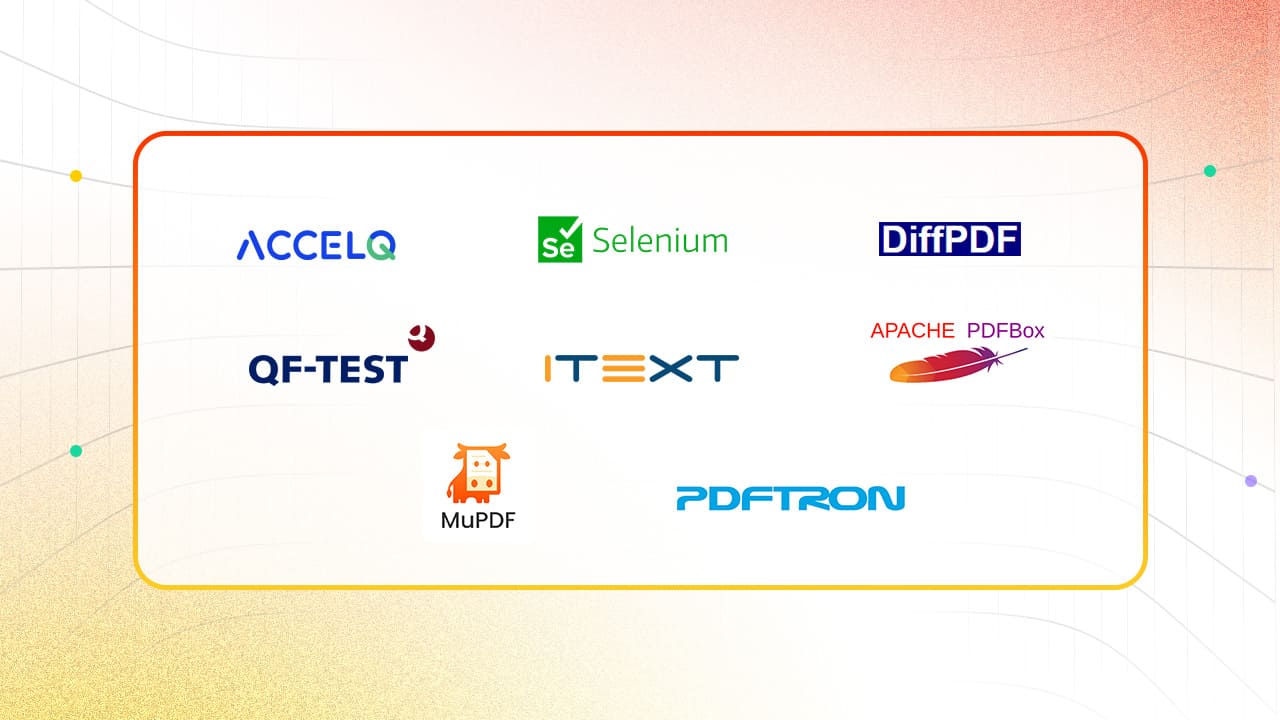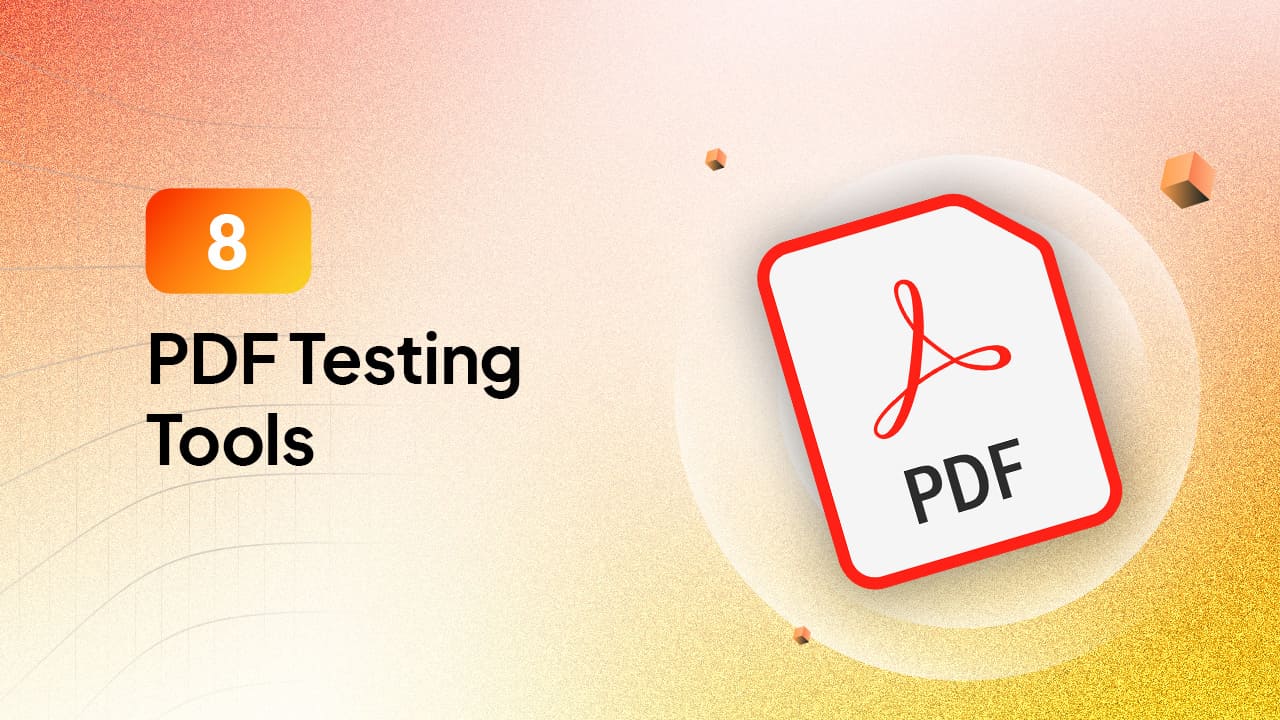Top 8 PDF Testing Tools in 2025

In a paperless era, PDF has become a standard format for creating documents like bank account statements and hotel booking confirmations. Testing a PDF document involves several steps, depending on what you want to check. However, some common checklists for testing PDF files are - ensuring the PDF opens correctly in PDF readers like Adobe Acrobat or web browsers. Links, bookmarks, and table of contents should work properly and target the right destination.
PDF automation tools can help to check and ensure thorough validation of your PDF files in the following ways. PDF accessibility checkers ensure that your PDF file meets standards and is helpful for people with disabilities. The tools support security testing to check if the correct permissions are set on the PDF, such as restrictions on printing or copying.
These tools also support regression testing to ensure that updates to the PDF do not introduce new issues. It is particularly useful for frequently updated documents and where multipage formatting is important, like monthly credit card statements. Let’s learn about the features of the top PDF testing tools and their pros and cons.
8 Best PDF Testing Tools
1. ACCELQ
ACCELQ testing platform revolutionizes PDF document validation with its AI-driven, codeless approach, making it seamless for teams to ensure accuracy, compliance, and consistency across digital documents. This platform empowers organizations to streamline PDF testing in diverse workflows by offering features like PDF recorder and verification commands.
Integrated with a broader automation ecosystem, ACCELQ can combine PDF and web, API, mobile, and desktop automation. In addition, this platform can locate the PDF file from the browser's download folder to streamline the process of working with PDF files generated as part of a web application flow involving PDF downloads.
Features:
- ACCELQ supports a PDF Recorder for recording automation statements on a PDF document.
- PDF Recorder supports files rendered in international languages and not just English-based ones.
- The platform supports locator-free and smart-locator options for element identification in PDF files to handle the extreme complexity of PDF file interactions and verifications.
- ACCELQ seamlessly integrates web and PDF automation logic with a set of statements that work on the web browser, followed by PDF automation tasks.
- This test automation platform supports verification commands to verify text formatting, styling, and more.
Pros & Cons of ACCELQ
- PDF recorder automates interactions without coding
- Verification commands validate PDF document elements, including text formatting, styling, and more
- Locator-free identification manages dynamic & complex PDF layouts
- No cons
2. Selenium

Selenium lacks built-in functionality for testing PDF content, so it requires using a third-party library like Apache PDFBox to achieve this. Apache PDFBox validates and tests PDF content in web applications for automated testing scenarios where PDFs are generated or displayed online. This integration enables Selenium to handle PDF files by leveraging Apache PDFBox to extract and verify content, such as text and specific page elements.
Features:
- Extracts text from PDF files to enable validations of content against expected values within automated test cases.
- Tests specific page ranges to validate large PDFs or focus on particular sections.
- Runs PDF tests within CI/CD pipelines to enable automated and continuous validation of PDF content across deployments.
- Open and switch between browser tabs to test PDFs that are launched as new tabs within a web application.
- With other tools, Selenium can test PDF interactions across browsers to ensure compatibility and consistency.
Pros & Cons of Selenium
- Automated extraction and verification of text within PDFs
- Seamlessly integrates with CI/CD for PDF testing
- Supports multiple browsers for comprehensive PDF testing
- Needs external libraries for PDF content reading
- Requires extra tools for complex PDF element interactions
- Content extraction from large PDFs may slow tests
3. iText

The iText PDF toolkit offers PDF engines written in Java and . NET. It allows you to integrate PDF functionalities into your workflow, applications, processes, or products.
Features:
- PDF inspector inspects the PDF’s internal dictionary content.
- pdfOptimizer reduces PDF file size with configurable optimization strategies.
- pdfHTML provides an API (Java/.NET) to convert HTML to PDF files.
- pdfSweep intervenes when editing a PDF document with watermarking tools.
- PDF Debugging inspects PDFs to find and fix bugs.
Pros & Cons of iText
- Supports multi-gigabyte PDFs and documents with thousands of pages
- HTML and CSS to design PDF layouts and style documents
- XFA technology enables dynamic field generation based on user responses
- Requires strong knowledge of PDF structures and Java coding
- Lacks verification commands, so cannot automate PDF validation
- High cost
4. MuPDF

MuPDF is a library for managing PDF documents. This library is licensed under the GNU AGPL, a complex license that allows users to use MuPDF for free building projects without warranty or support.
Features:
- This library supports PDF processing and visualization for desktop and server applications.
- Render PDFs for web applications.
- Creates print previews, annotates, and redacts documents in a .NET environment.
- A canonical repository of this library has Java platform code to develop desktop apps.
- An Android library is supported for mobile PDF viewing and development.
Pros & Cons of MuPDF
- Ideal for applications requiring fast PDF rendering and processing
- Supports multiple platforms and integrates with Java applications
- Renders PDFs effectively, supporting document validation
- Limited PDF editing capabilities
- Lacks testing features, requiring additional development
- Requires familiarity with C# programming
5. Apache PDFBox

Apache PDFBox is an open-source Java tool for working with PDF documents. It allows you to create new PDF documents, manipulate existing documents, and extract content from documents.
Features:
- Unicode text is extracted from PDF files.
- A single PDF is split into many files or merges many PDF files.
- Extracts data from PDF forms or fills a PDF form.
- PDF files are validated against the PDF/A-1b standard.
- A PDF file is printed using the standard Java printing API.
- PDFs are saved as PNG or JPEG image files.
- A PDF is created from scratch with embedded fonts and images.
- Digitally sign PDF files.
Pros & Cons of Apache PDFBox
- Open-source, a cost-effective option for teams to extract and edit PDF files
- Creates, modifies, and extracts text from PDFs
- Integrates with Java apps to add PDF features into Java-based testing frameworks
- Lacks features like a recorder, making it complex to use
- Requires coding and making it less accessible for non-technical users
- Migrating to new versions causes workflow disruptions due to lost or changed functionalities
6. QF-Test

QF-Test is a tool for automating functional tests for Java or web applications. Version 4.2 is the option to test PDF documents and their elements about textual and graphical correctness.
Features:
- PDF test automation and comparison of PDF documents are supported.
- Recorder of this tool supports test creation.
- This tool can test mobile applications on real devices and emulators.
- Continuous integration tools, test management, and version control tools integration are supported.
- Detailed run-logs with debugger functionality in HTML and XML format to analyze errors and include screenshots of the error situation.
Pros & Cons of QF - Test
- Recorder simplifies test automation for PDF applications
- Provides detailed logs with debugging capabilities to troubleshoot errors
- Integrates with CI and version control for seamless dev pipeline automation
- Needs extra customization for detailed PDF validation
- Requires custom scripts for certain PDF testing scenarios
- Limited effectiveness in non-Java mobile environments
7. PDFTron

PDF SDK is one of Apryse's products, previously known as PDFTron. It is a set of tools and resources that help developers create, manipulate, and modify PDF files in their software applications.
Features:
- High-fidelity viewing and precision editing capabilities for PDF documents across web, mobile, and desktop platforms
- Converts PDF into ISO-compliant PDF/A documents by supporting various compliance levels, including VeraPDF validations.
- Generates documents by populating PDF, DOCX, PPTX, and HTML templates with data from existing data storage.
- Inserting, removing, or rearranging PDF pages is supported.
- This tool creates custom signing workflows to certify, validate, and seal digitally signed documents.
Pros & Cons of PDFTron
- Viewing and editing options enable thorough PDF review and testing
- Supports conversion to PDF/A with compliance and validations
- Digital signatures add flexibility for testing document signing scenarios
- High resource usage for processing large PDF documents
- Steep learning curve for non-developers
- High cost for advanced features like digital signing
8. DiffPDF
DiffPDF is used to compare two PDF files either textually or visually. It offers three comparison modes: Words, Characters, and Appearance.
Features:
- Words, characters, or appearance comparison is supported for PDF documents.
- Users can specify page ranges for comparison, which is helpful for documents with additional or missing pages in different versions.
- Differences are visually highlighted within the PDF, making it easy to identify modifications between versions.
- This tool is accessible to users across operating systems.
- All comparisons are processed locally, ensuring document confidentiality.
Pros & Cons of DiffPDF
- Multiple modes assist in verifying PDF content and visual design changes
- Page range selection helps compare versions with different page counts
- Accessible across various operating systems
- No automation support, so less suited for automated PDF testing
- Lacks PDF document management and processing
- PDF comparisons are processed locally, not cloud-based
Conclusion
Companies have largely handled and automated the testing of their web and mobile applications. Yet, they struggle to automate PDF testing within various processes. So, utilizing the capabilities of AI in testing for a completed PDF document along with testing dynamic data will help your team include PDF testing as a part of their end-to-end testing instead of manual testing. PDF testing automation tools can check the quality of documents and help organizations perform PDF validation efficiently.
ACCELQ PDF testing platform will be helpful for organizations to seek precise, automated validation of their PDF documents. The platform eliminates manual comparison efforts, enhances accuracy, accelerates test cycles, and ensures data integrity across critical business documents. With its intuitive user interface, robust integration capabilities, and verification commands, ACCELQ empowers teams to verify PDF content, layouts, and structures at scale.
Say goodbye to manual checks and achieve flawless PDF testing with ACCELQ by booking a free trial today.
Discover More
 Top 5 Selenium Alternatives For Automation Testing In 2025
Top 5 Selenium Alternatives For Automation Testing In 2025
Top 5 Selenium Alternatives For Automation Testing In 2025
 Top 10 BDD Testing Tools In 2025
Top 10 BDD Testing Tools In 2025

































